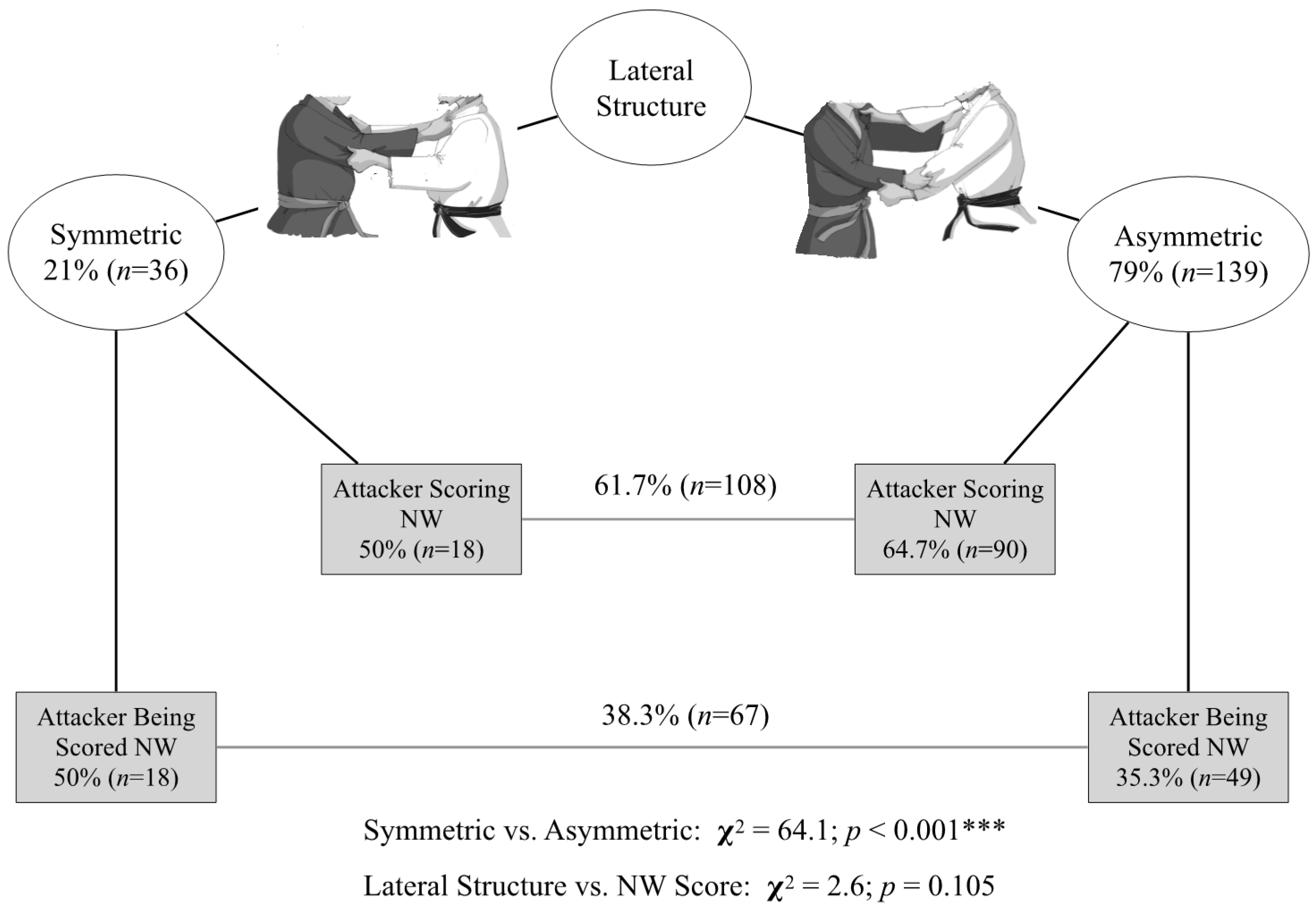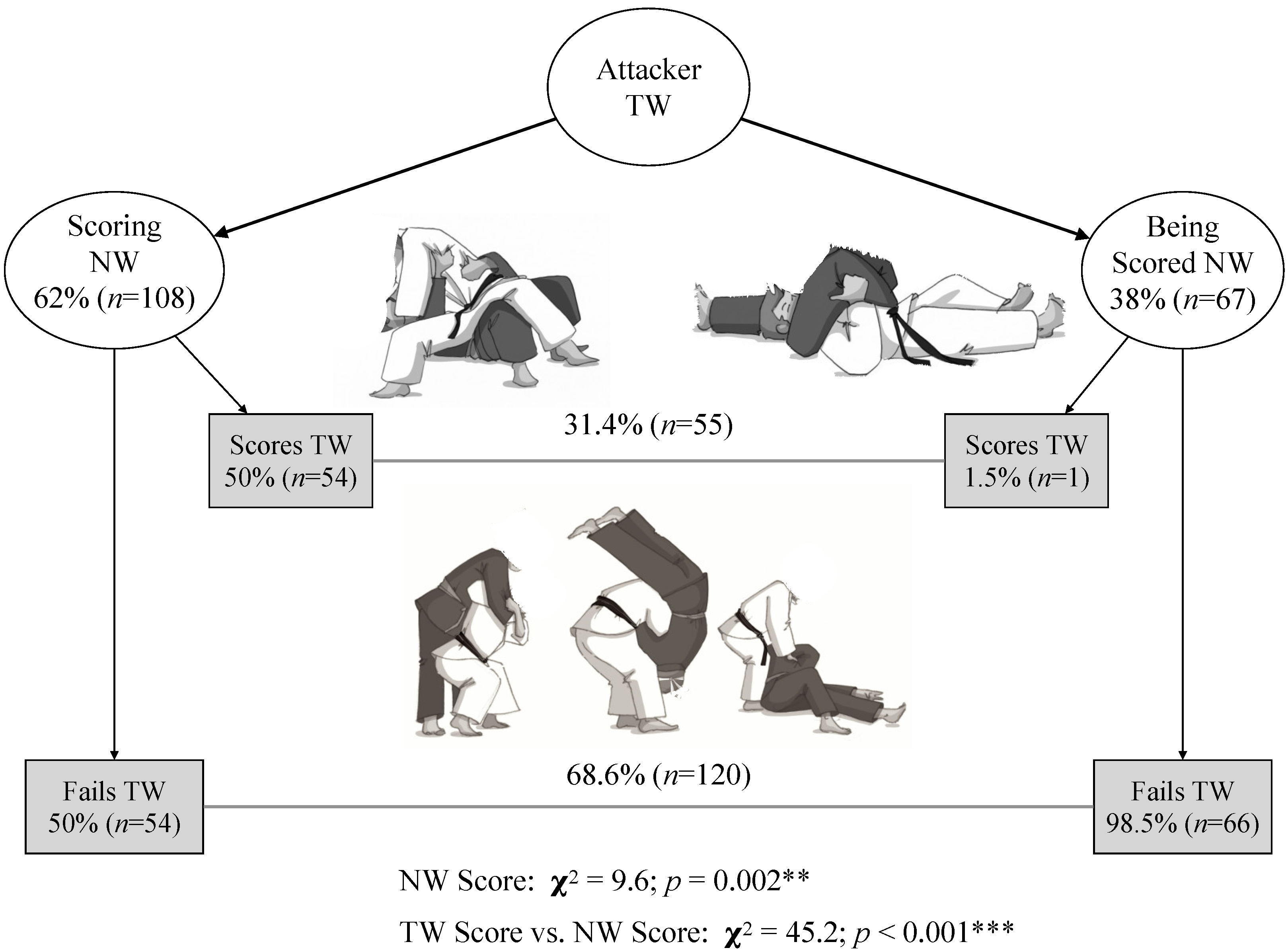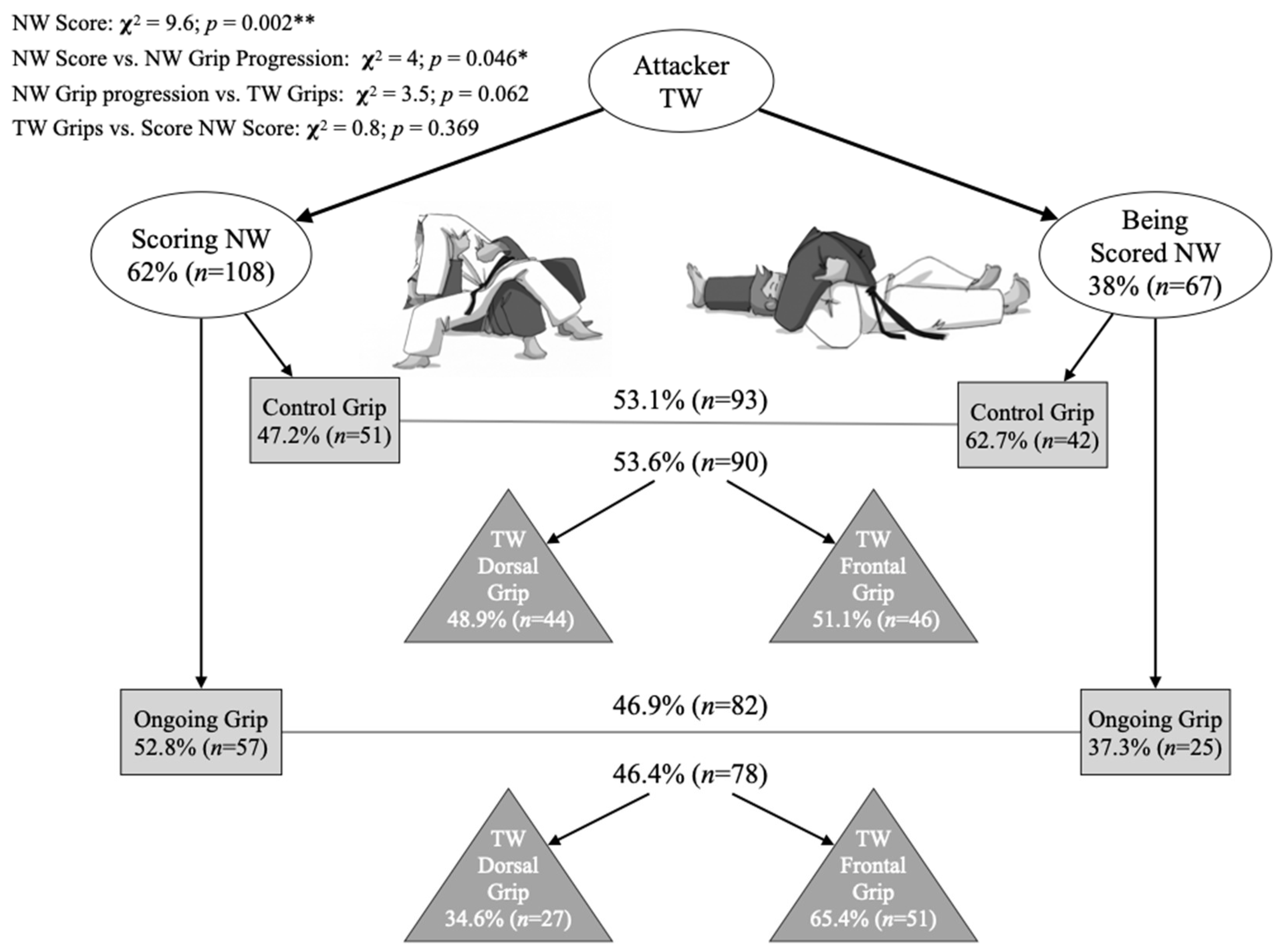Analysis of Successful Behaviors Leading to Groundwork Scoring Skills in Elite Judo Athletes
Abstract
:1. Introduction
2. Materials and Methods
2.1. Design
2.2. Procedures
2.3. Statistical Analysis
3. Results
3.1. Temporal Units, Sequences Duration, Weight Categories, and Sex
3.2. Position Progressions and the Type of NW Grappling Skill Scoring Action
3.3. Lateral Structure, Movement Structure, Scoring in TW, and Relationship between Scoring in TW vs. Scoring in NW
3.4. Attacking Grips during TW Context and Grips Progression during NW Scoring Actions
4. Discussion
5. Conclusions
- Practice the connection of all grappling skills in NW after failed attacks preceded by TW situations with asymmetric lateral structure and when the attacker uses skills without turn.
- Use preferably dorsal-sleeve and flap-sleeve grips in the preceding TW actions.
- Train both roles, attacker and defender.
Author Contributions
Funding
Institutional Review Board Statement
Informed Consent Statement
Data Availability Statement
Conflicts of Interest
References
- Franchini, E.; Artioli, G.G.; Brito, C.J. Judo Combat: Time-Motion Analysis and Physiology. Int. J. Perf. Anal. Sport 2017, 13, 624–641. [Google Scholar] [CrossRef]
- Fernández, E.C. Analysis of the Acute Effects of the Confrontation in the Judo, through the Study of the Association between Metabolic and Mechanical Parameters. Fit. Perform. J. 2008, 7, 229–238. [Google Scholar] [CrossRef]
- Marcon, G.; Franchini, E.; Jardim, J.R.; Neto, T.L.B. Structural Analysis of Action and Time in Sports: Judo. J. Quant. Anal. Sports 2010, 6, 1–13. [Google Scholar] [CrossRef]
- Sterkowicz-Przybycien, K.; Blecharz, J.; Sterkowicz, S.; Luszczynska, A. Attention and Acute Judo-Specific Effort in Athletes Preparing for Olympic Competition. Arch. Budo. 2015, 11, 265–270. [Google Scholar]
- International Judo Federation. Sport and Organisation Rules. 8 July 2020. Available online: https://www.ijf.org/documents (accessed on 13 March 2021).
- Brito, C.J.; Miarka, B.; de Durana, A.L.D.; Fukuda, D.H. Home Advantage in Judo: Analysis by the Combat Phase, Penalties and the Type of Attack. J. Hum. Kinet. 2017, 57, 213–220. [Google Scholar] [CrossRef] [PubMed] [Green Version]
- Miarka, B.; Panissa, V.L.G.; Julio, U.F.; Vecchio, F.B.D.; Calmet, M.; Franchini, E. A Comparison of Time-Motion Performance between Age Groups in Judo Matches. J. Sport Sci. 2012, 30, 899–905. [Google Scholar] [CrossRef] [PubMed]
- Miarka, B.; Vecchio, F.B.D.; Julianetti, R.; Cury, R.; Camey, S.; Franchini, E. Time-Motion and Tactical Analysis of Olympic Judo Fighters. Int. J. Perf. Anal. Sport 2016, 16, 133–142. [Google Scholar] [CrossRef]
- Challis, D.; Scruton, A.; Cole, M.; Callan, M. A Time-Motion Analysis of Lightweight Women’s Judo in the 2010 World Championships. Int. J. Sports Sci. Coach. 2015, 10, 479–486. [Google Scholar] [CrossRef] [Green Version]
- Miller, G.A.; Collins, N.A.; Stewart, M.J.; Challis, D.G. Throwing Technique and Efficiency in the 2013 British Judo Championships. Int. J. Perf. Anal. Sport 2015, 15, 53–68. [Google Scholar] [CrossRef]
- Miarka, B.; Branco, B.H.M.; Vecchio, F.B.D.; Camey, S.; Franchini, E. Development and Validation of a Time-Motion Judo Combat Model Based on the Markovian Processes. Int. J. Perf. Anal. Sport 2015, 15, 315–331. [Google Scholar] [CrossRef]
- Nagai, S.; Takito, M.Y.; Calmet, M.; Pierantozzi, E.; Franchini, E. Successful Transition to Groundwork Combat during Junior and Senior Judo World Championships. Int. J. Perf. Anal. Sport 2019, 19, 1–10. [Google Scholar] [CrossRef]
- Mayo, X.; Dopico-Calvo, X.; Iglesias-Soler, E. An Analysis Model for Studying the Determinants of Throwing Scoring Actions During Standing Judo. Sports 2019, 7, 42. [Google Scholar] [CrossRef] [PubMed] [Green Version]
- International Judo Federation. Detailed Explanation of the IJF Judo Refereeing Rules. Version 26 October 2017. Available online: https://www.ijf.org/news/show/detailed-explanation-of-the-ijf-judo-refereeing-rules (accessed on 12 March 2021).
- Dopico-Calvo, X.; Iglesias-Soler, E.; Carballeira, E. Classification of Judo Motor Skills Tactical and Motor Criteria Approach. Arch. Budo Sci. Martial Arts Extrem. Sports 2014, 10, 75–83. [Google Scholar]
- Cohen, J. Statistical Power Analysis for the Behavioral Sciences, 2nd ed.; Hillsdale, N.J., Ed.; Lawrence Erlbaum Associates: New York, NY, USA, 1988; ISBN 9780805802832. [Google Scholar]
- Kerby, D.S. The Simple Difference Formula: An Approach to Teaching Nonparametric Correlation1. Compr. Psychol. 2014, 3, 1–9. [Google Scholar] [CrossRef]
- Miarka, B.; Fukuda, H.D.; Heinisch, H.-D.; Battazza, R.; Vecchio, F.B.D.; Camey, S.; Franchini, E. Time-Motion Analysis and Decision Making in Female Judo Athletes during Victory or Defeat at Olympic and Non-Olympic Events: Are Combat Actions Really Unpredictable? Int. J. Perf. Anal. Sport 2017, 16, 442–463. [Google Scholar] [CrossRef]
- Soriano, D.; Irurtia, A.; Tarragó, R.E.; Tayot, P.; Milà-Villaroel, R.; Iglesias, X. Time-Motion Analysis during Elite Judo Combats (Defragmenting the Gripping Time). Arch. Budo 2019, 15, 33–43. [Google Scholar]
- Soto, D.A.S.; Aedo-Muñoz, E.; Brito, C.J.; Camey, S.; Miarka, B. Making Decisions and Motor Actions with Technical Biomechanical Classifications in Male Judo Weight Categories. J. Hum. Kinet. 2020, 72, 241–252. [Google Scholar] [CrossRef] [PubMed] [Green Version]
- Bello, F.D.; Aedo-Muñoz, E.; Brito, C.J.; Miarka, B. Performance Analysis and Probabilities by Gender in Judo: Combat Phases, Techniques and Biomechanical Levers. Facta Univ. Ser. Phys. Educ. Sport 2019, 17, 135–148. [Google Scholar] [CrossRef]
- Miarka, B.; Brito, C.J.; Amtmann, J.; Córdova, C.; dal Bello, F.; Camey, S. Suggestions for Judo Training with Pacing Strategy and Decision Making by Judo Championship Phases. J. Hum. Kinet. 2018, 64, 219–232. [Google Scholar] [CrossRef] [PubMed] [Green Version]
- Gutiérrez-Santiago, A.; Gentico-Merino, L.A.; Prieto-Lage, I. Detection of the Technical-Tactical Pattern of the Scoring Actions in Judo in the Men’s Category of −73 Kg. Int. J. Perf. Anal. Sport 2019, 19, 778–793. [Google Scholar] [CrossRef]



| Concept | Abbreviations | Description |
|---|---|---|
| Temporal Units | TU | |
| TU1 | 1st temporal unit (from 0 to 59 s) | |
| TU2 | 2nd temporal unit (from 60 to 119 s) | |
| TU3 | 3rd temporal unit (from 120 to 179 s) | |
| TU4 | 4th temporal unit (from 180 to 240 s) | |
| GS | Golden score | |
| Tachi-waza | TW | Standing Judo |
| Ne-waza | NW | Groundwork Judo |
| Ne-waza Grappling Score | NWGS | Groundwork grappling skills for scoring in judo: osae-komi-waza, kansetsu-waza, and shime-waza |
| Osae-komi-waza | OW | Immobilization techniques |
| Kansetsu-waza | KW | Neck choke-holding techniques |
| Shime-waza | SW | Elbow locking techniques |
| Ne-waza Sequence Duration | OW sequence duration comprised from NW beginning to the referee indication of the beginning of immobilization. Time spent to get a score once immobilization started was not computed. KW and SW sequence duration comprised from NW beginning up to score by adversary surrender | |
| Ne-waza Grip Progression | ||
| Control grip | The judoka who scored in NW maintained at least one hand from the TW attack to NWGS | |
| Ongoing grip | The judoka who scored in NW changed both hands (i.e., new grips) from the TW attack to NWGS | |
| Ne-waza Position Progression | ||
| SPP | Short position progression consists of zero or one change in the posture of the NW-attacker or NW-defender | |
| LPP | Long position progression consists of at least two to six changes in the posture of the NW-attacker or NW-defender | |
| Tachi-waza Attacker Grips | ||
| Dorsal | At least one hand is in the dorsal part of the adversary judo suit. For example: dorsal-flap, dorsal-sleeve, and dorsal-free | |
| Frontal | Both hands were in the frontal part of the adversary judo suit. For example, flap-flap, flap-sleeve, flap-free, sleeve-sleeve, and sleeve-free | |
| Tachi-waza Lateral Behavior | ||
| Attacker right turning behavior | If the rotation of the right shoulder turns to the left (anticlockwise), or a dynamic right leg applies a technique | |
| Attacker left-turning behavior | If the rotation of the left shoulder turns to the right (clockwise), or a left dynamic leg applies a technique | |
| Defender right behavior | If the advanced leg was the right at the moment of the attack | |
| Defender left behavior | If the advanced leg was the left at the moment of the attack | |
| Tachi-waza Lateral Structure | ||
| Symmetrical | The attacker and the defender were right versus right or left versus left | |
| Asymmetrical | The attacker and the defender adopted different relative positions, right versus left or left versus right | |
| Tachi-waza Movement Structure | ||
| T-TW | Tachi-waza techniques with turning | |
| WT-TW | Tachi-waza techniques without turning | |
| SP | Tachi-waza techniques performed during supine position |
Publisher’s Note: MDPI stays neutral with regard to jurisdictional claims in published maps and institutional affiliations. |
© 2022 by the authors. Licensee MDPI, Basel, Switzerland. This article is an open access article distributed under the terms and conditions of the Creative Commons Attribution (CC BY) license (https://creativecommons.org/licenses/by/4.0/).
Share and Cite
Dopico-Calvo, X.; Iglesias-Soler, E.; Santos, L.; Carballeira, E.; Mayo, X. Analysis of Successful Behaviors Leading to Groundwork Scoring Skills in Elite Judo Athletes. Int. J. Environ. Res. Public Health 2022, 19, 3165. https://doi.org/10.3390/ijerph19063165
Dopico-Calvo X, Iglesias-Soler E, Santos L, Carballeira E, Mayo X. Analysis of Successful Behaviors Leading to Groundwork Scoring Skills in Elite Judo Athletes. International Journal of Environmental Research and Public Health. 2022; 19(6):3165. https://doi.org/10.3390/ijerph19063165
Chicago/Turabian StyleDopico-Calvo, Xurxo, Eliseo Iglesias-Soler, Luis Santos, Eduardo Carballeira, and Xián Mayo. 2022. "Analysis of Successful Behaviors Leading to Groundwork Scoring Skills in Elite Judo Athletes" International Journal of Environmental Research and Public Health 19, no. 6: 3165. https://doi.org/10.3390/ijerph19063165
APA StyleDopico-Calvo, X., Iglesias-Soler, E., Santos, L., Carballeira, E., & Mayo, X. (2022). Analysis of Successful Behaviors Leading to Groundwork Scoring Skills in Elite Judo Athletes. International Journal of Environmental Research and Public Health, 19(6), 3165. https://doi.org/10.3390/ijerph19063165









